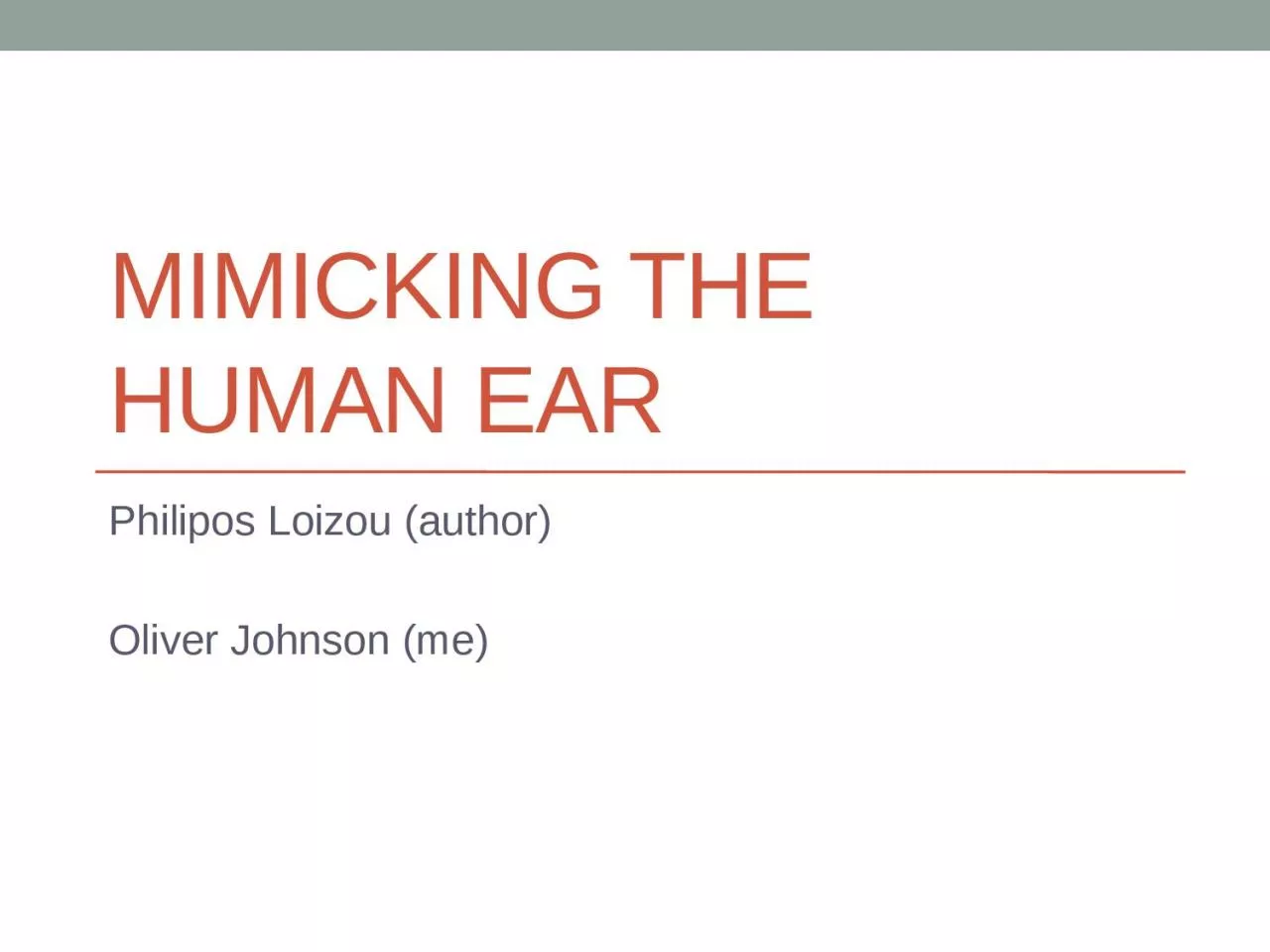

Loizou author Oliver Johnson me Anatomy and signal processing of the Ear Von Bekesy max freq response by location in Basilar membrane Implants are for people with hair cell loss causing profound deafness 90dB or more and functioning cochlear nerve ID: 931630
Download Presentation The PPT/PDF document "Mimicking the Human ear Philipos" is the property of its rightful owner. Permission is granted to download and print the materials on this web site for personal, non-commercial use only, and to display it on your personal computer provided you do not modify the materials and that you retain all copyright notices contained in the materials. By downloading content from our website, you accept the terms of this agreement.
Slide1
Mimicking the Human ear
Philipos
Loizou
(author)
Oliver Johnson (me)
Slide2Anatomy and signal processing of the Ear
Von Bekesy, max freq. response by location in Basilar membrane
Implants are for people with hair cell loss causing profound deafness (90dB or more) and functioning cochlear nerve.
Slide3Auditory Encoding theories
Place Theory
Neural amplitude of firing differs by location for different frequencies. Brain decodes combination of amplitudes’ location of firing.
Motivates multichannel implants.Volley Theory, frequency determined by neuron firing rate.Nerve fibers fire at rates proportional to period of input signal, up to 5kHz. Low frequencies nerve fibers fire at each cycle, high frequency is encoded by combinations of groups.
Is this not spatially dependent?
Slide4Speech Encoding
Source-filter model
of speech production
Linear system of F0, F1, F2, F3
Slide5Cochlear Implant Design
Transmission
Link
Electrode DesignStimulation Type
Signal Processing
Slide6Electrode Design
Typically implanted near the
scala
tympani to be near the auditory neurons that lie along the length of the cochlea (preserves ‘place’ mechanism
Bipolar vs. MonopoleInsertion depthUp-shifting in frequency when F0 is represented at 22mm depth
Slide7Single Channel vs
Multi-Channel
Author surprised at success rate for single channel implants.
Single Channel
Limited spectral informationSignal contains information on F0 and F1, some patients could discriminate F2Used temporal encoding only up to 1kHz (neural refractory)
Can extract freq information from periodicity of input stimulus up to 300-500HzMultiHow many electrodes to use
What information should be transmitted, what does the ear encode
Slide8Stimulation Types – Waveform Strategies
Compressed Analog and Continuous Interleaved Sampling Approaches
Analog
Advantages: Contiguous frequency bands, simpler electronics
Disadvantages: Cross channel interferencePulsatileAdvantages: Increase pulse rates,
more control over stimulation ordering, canenvelope signal to person’s dyn. range.
Implant listeners range as low as ~5dB
Disadvantages: Required digital
impl
.
Slide9CA and pulsatile comparison
Slide10CA vs
CIS
Slide11Slide12Electrode placement and mapping
Slide13Speech Decoding – Feature Extraction
MPEAK
saying “
sa”
Slide14Speech Decoding
SMSP displaying pronunciation of
the word “choice”
Slide15Speech Decoding
SPEAK
Pronunciation of several
phonemes.
Slide16Hybrid Systems
Spectral Maxima Sound Processor (SMSP)
Combines CIS components with more electrodes doing feature extraction for spatial mapping
Electro-Acoustic Systems
Low freq hearing aid amp. Cochlear implant for high frequencies
Slide17Improvement in speech and hearing
Slide18Factors Affecting performance
Duration of Deafness
Age of onset
People with post-lingual deafness perform better than those with pre-lingual deafnessAge at implantation
Possibly minimum age of 2, better young than older.Duration of implant useIndividual Factors Number of surviving spiral ganglion cellsElectrode placement and electrode depth
Electrical dynamic rangeSignal processing strategy
Slide19Pre- vs. Post-
lingually
deafened performance comparison
Slide20Implantation timeline
Slide21Conclusions (look at more recent papers)
Proven that profoundly deaf people can hear and speak with the implant. Longitudinal studies have shown this to be true for a majority of pre-
lingually
deaf as well
Auditory performance is most positively affected by two factorsAcquiring speech and language before hearing lossShorter duration of deafnessSignal processing advances in both speed of processing and speech decoding
Slide22Future work
Continued comparison of feature extraction vs. CIS methods.
Discover more Inter-patient performance variability factors
Develop tests to predict a person’s performance pre-surgically, such as the P100 look at visual cortical re-mapping.
Electrode array design for high degree of specificity to allow finer channel selectivity
Slide23Questions raised…
Comparison of what processing strategies work better for pre- vs. post-lingual deafness onset
Longitudinal studies for implantation success (one study with 30 people only had 9 electrode replacements in 8 people) over a 10 year study
A lot of manual refinement by audiologists, did not see much in terms of optimizing algorithms/adaptive learning
As a model for other BMIs for how long it takes a person to truly integrate with a machine interfaceInitiate Real discussions on ‘elective’ BMI procedures, gives us a roadmap for future applications.
Spoken language differences